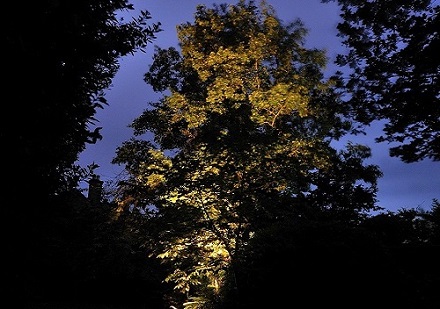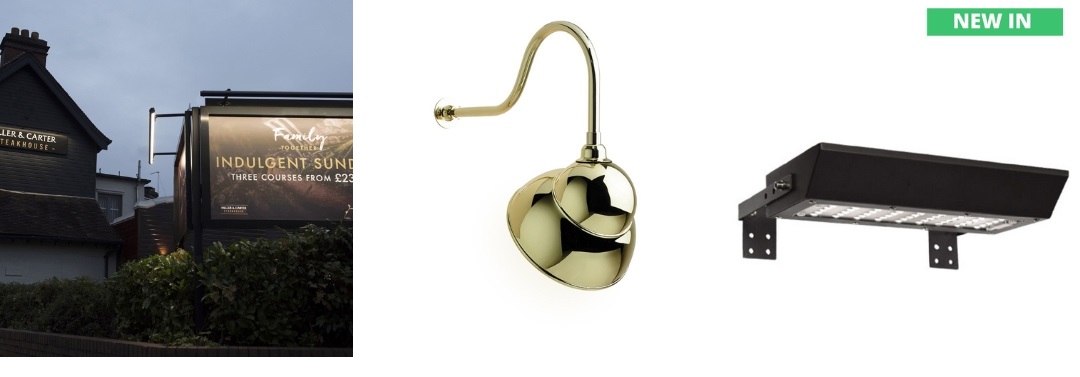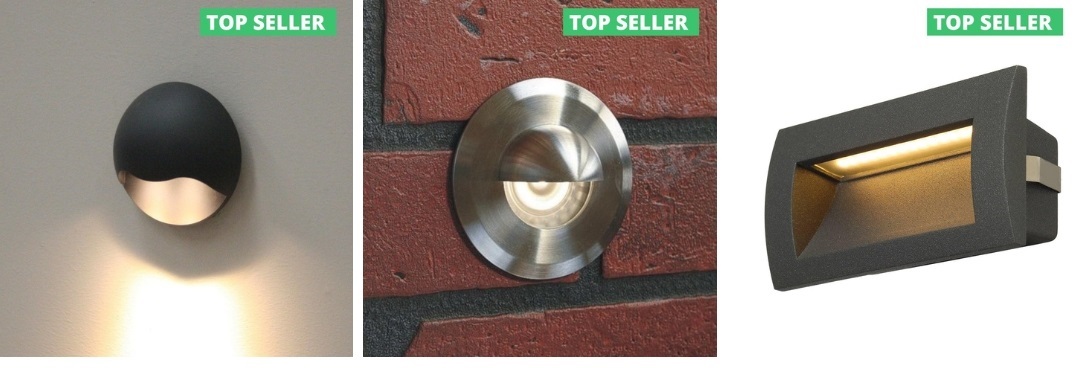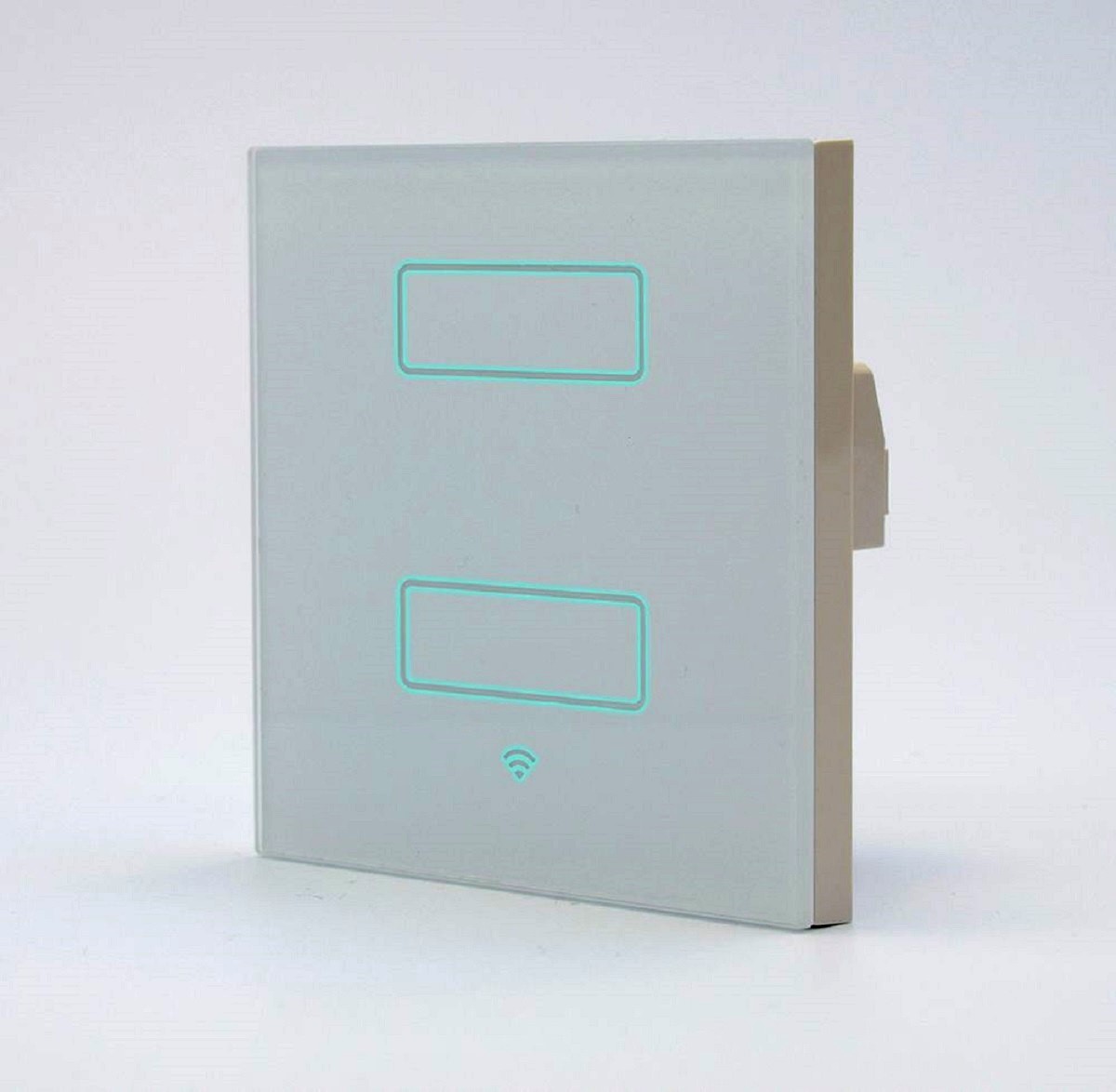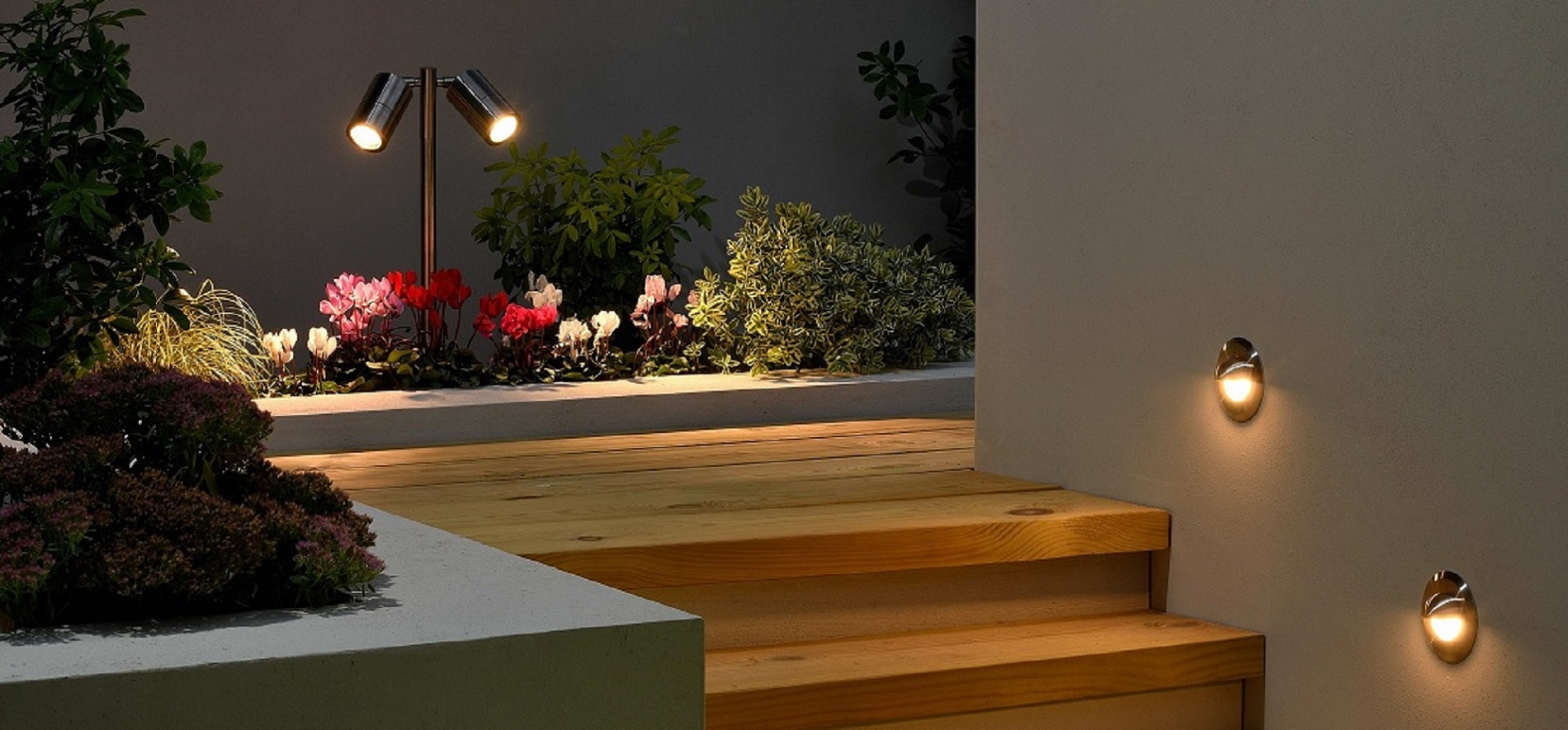What is an IP Rating?
The official explanation is given below but in simple terms rather than someone just saying an object is waterproof the IP
rating gives the product a measure of how waterproof the item is by using a two digit code. The design of the light
fitting also has an impact on the IP rating, for example an IP44 bollard is totally adequate as the water falls down
the light fitting and not directly towards the lamp source, however a directional spot light would have a higher
IP rating as water can be directed straight on the lens where the lamp is housed. If a light fitting needs to be
fully submersed in water then an IP rating of IP68 would be required.
The IP Code (or International Protection Rating, sometimes also interpreted as Ingress Protection Rating) consists of the
letters IP followed by two digits and an optional letter. As defined in international standard IEC 60529, it
classifies the degrees of protection provided against the intrusion of solid objects (including body parts like
hands and fingers), dust, accidental contact, and water in electrical enclosures. The standard aims to provide
users more detailed information than vague marketing terms such as "waterproof". May
also be known as “Index of Protection”.
The digits ('characteristic numerals') indicate conformity with the conditions summarised in the tables below. Where there is no protection rating with regard to one of the criteria, the digit is replaced with the letter X.
For example, an electrical socket rated IP22 is protected against insertion of fingers and will not be damaged or become unsafe during a specified test in which it is exposed to vertically or nearly vertically dripping water. IP22 or IP2X are typical minimum requirements for the design of electrical accessories for indoor use. FIG 1 shows the IP ratings.
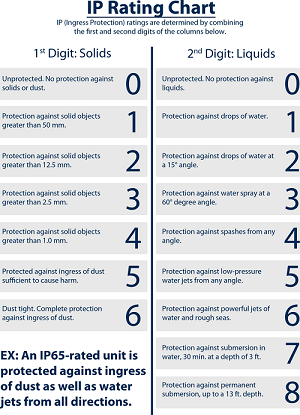
Main 220v - 240v LED fittings versus Low Voltage 12v and 24v fittings
Within our product range you will come across a number of light fittings that utilise the latest LED technology. The only direct way to compare the light output of an LED lamp (bulb) is to look at the lumen value and how much it produces. The higher the lumens the brighter the lamp. We still sell Metal Halide fittings too specifically for very tall trees and buildings although LED technology is fast catching up with powerful lumen output and energy savings with low wattages.
You now need to take each of the four bullet points below in isolation for advantages and disadvantages and this will help you make an informed choice of the product you require.
1. A mains 220v - 240v light fitting with built in LED lamp and control gear
Advantage: Easy to install, no transformer or lamp to worry about.
Disadvantage : If the fitting should fail in the future then the whole fitting may need to be replaced (unless
the LED module is replaceable) and there is always the possibility that the product may have gone out of production,
there is a restricted choice of lamp lumen output.
2. A mains 220v - 240v light fitting that will take a retrofit LED lamp
Advantage: A big choice of retrofit lamps are available, no need to replace the whole fitting if a lamp
fails, no transformer or control gear to worry about.
Disadvantage: Requires high voltage 240v SWA ( steel wire armoured ) cable supply
3. A 12v light fitting that has a built in LED lamp but requires a transformer to drive it
Advantage: Very low voltage supply, transformer can be placed up to 30 metres away, easy to install,
very low voltage drop.
Disadvantage: Needs a transformer, If the fitting should fail in the future then the whole fitting may need to be replaced (unless the LED module is replaceable, restricted lumen output choice.
4. A 12v low voltage light fitting that will take a retrofit LED lamp
What material should I use?
When purchasing exterior lighting products it is important to know the differences in the various metals and materials used for the environment they are going into. Many clients purchase outdoor lighting based on the way the fixture looks as well as the light source, but don’t pay much attention to the materials used in the construction. At exterior lights UK we advise our clients on the pros and cons of various materials used in outdoor fixtures including copper, stainless steel, aluminium, brass and plastics.
Aluminium Outdoor Lighting
Aluminium fixtures are very affordable, but are of the lowest quality of the metals we will discuss and are simply not designed to last for a long period of time outdoors compared to a higher grade metal. Over time, the aluminium will oxidise and the paint will fade quite a bit but a good quality powder coat or clear lacquer will slow the process and preserve the look of the luminaire. Aluminium doesn’t hold up well around salt and will corrode over time and is not recommended for coastal applications. Exterior lights UK have a large variety of aluminium outdoor fixtures as they are the most affordable option and ideal for those on a budget.
Stainless Steel Outdoor Lighting. ( 304 and 316 )
Stainless Steel is the best material for a long lasting low corrosion luminaire. Stainless steel must be cleaned to keep it looking beautiful and to protect it from corrosion. Stainless steel is protected from corrosion by a layer of chromium oxide, but this layer is compromised by sand, dirt and other materials. Constant cleaning is vital to maintain the layer of chromium oxide to prevent corrosion. Each product has details of 'after care' on the website to give you guidance on how to care for your light fittings.
What is 304 and 316 Stainless Steel ?
Stainless steel is available in many different grades, the two most common used in exterior lighting products are 304 and 316
In very simple terms it comes down to it's Nickel content. The higher the Nickel content the better the stainless Steel. Nickel on it's own is extremely expensive, this is the main reason why you pay so much more for Stainless Steel then for normal metal. 304 grade has a lower content of Nickel compared to 316 grade stainless steel. 90% of the time 304 stainless steel is more than adequate for exterior lighting.
How can I tell Stainless Steel from normal metal ?
Well unless you have a microscope and a degree in metallurgy it will not be obvious. However one thing you can try is a magnet. You will find that most stainless steel products will not be magnetic. So when you put a magnet against it, it should just fall off. This test is just a gauge and may not work all of the time. Type 316 is also austenitic, non-magnetic.
Will 304 and 316 grade Stainless Steel rust ?
This greatly depends on where you put it. However Stainless Steel is like any product you purchase. It will not last forever if you do not take care of it. While 316 will certainly give you the best protection against rust, it still requires the occasional wipe down to remove any build up such as salt. If you live within about 20 miles of the Coast then we would strongly recommend 316 in all your outdoor fittings as grade 304 will not last as long under these conditions.
Brass Outdoor Lighting
Brass is a hard metal that holds up well in all environments and is made from a combination of copper and zinc. Brass fixtures will last for many years. Brass will “patina” or turn darker over time as it is exposed to the elements, but it will not corrode and is a great option for outdoor and landscape lighting. Brass fixtures are great options for coastal environments. Brass fixtures tend to be more expensive than some of the other metals used, but is the best quality and most durable metal that will last the longest.
Copper Outdoor Lighting
Copper is another great quality option for outdoor lighting. Copper is not quite as solid as brass. Copper will also “patina” over time and will darken when exposed to the elements. Copper prices continue to rise as the reserves continue to be depleted throughout the world, so one downfall of copper fixtures is that there is the potential that they will be stolen due to the value of the metal.
Plastic Outdoor Lighting
Plastic is a simple term for a polycarbonate material which is used for external lighting products. It is strong, will not corrode and will never need painting and is ideal as a low maintenance light fitting. They are also generally at the budget end of the market which makes them very affordable.
Powder coated product finish
Powder coating is a high-quality finish found on thousands of products you come in contact with each day.
Powder coating protects the roughest, toughest machinery as well as the household items you depend
on daily. It provides a more durable finish than liquid paints can offer, while still providing
an attractive finish. Powder coated products are more resistant to diminished coating quality as
a result of impact, moisture, chemicals, ultraviolet light, and other extreme weather conditions. In
turn, this reduces the risk of scratches, chipping, abrasions, corrosion, fading, and other wear issues.
It's tough. It looks great and it lasts a long, long time. In addition to being durable, powder coating
is an attractive choice due to environmental advantages. The best powder coated products will be on Stainless
Steel. Remember that Aluminium is a low quality metal and if installed in a coastal environment the powder
coating will start to show signs of rust relatively quickly.
Anodised product finish
Anodising is an electrochemical process that converts the metal surface into a decorative, durable, corrosion-resistant, anodic oxide finish. Aluminium is ideally suited to anodising, although other non-ferrous metals, such as magnesium and titanium, also can be anodised. The anodic oxide structure originates from the aluminium substrate and is composed entirely of aluminium oxide. This aluminium oxide is not applied to the surface like paint or plating, but is fully integrated with the underlying aluminium substrate, so it cannot chip or peel. It has a highly ordered, porous structure that allows for secondary processes such as colouring and sealing.
What style of fitting should I choose?
The design ideas section will also help you decide on what style of fitting will best suit your needs, for example if you were to illuminate a pergola it can be done in several ways.
1. Mount an up / down light on the main up rights. An example is our Odyssey up/down light ST5008W
2. Mount a down light only from the top of the main up rights. An example is our Odyssey fixed downlight ST5009W
3. Put buried lights in the ground next to each up right. An example is our Pillar marine grade up-light 52212
4. Use hanging lights of the main cross members to create pools of light on the floor. An example is our Starlight LSTRSV-12v
Pergola with ground mounted up lights
So from this one example you will need to choose how you want the area to look and that will then lead you to the type of light fitting most suitable to create the effect you want.
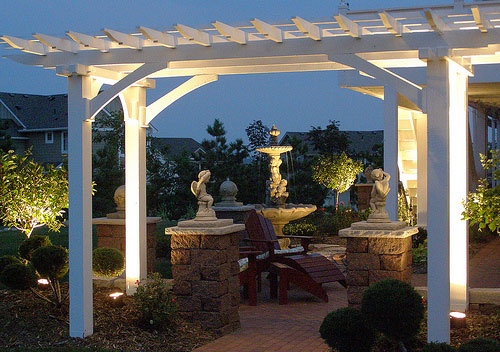
Pergola up-lit
Another example would be up lighting trees in a garden. You will need to establish the solid type or location first as a clay based soil does not allow for drainage so you would need to use a surface mounted spike light not a ground buried light. Think about where you want to use the light first and what you are trying to achieve.
-
Use an Adjustable buried up light in non clay based soils only and place at the base of the tree to up-light
the trunk or approximately 800mm - 1m from the base of the tree to up-light the foliage and branches. An example
is our Delphi with integral warm white 44w LED.
E99252WWN
- Use a surface mounted spike light in clay based soil and position the fitting as point 1 above. The beauty of spike lights is that you can simply move them to suit what you want to illuminate and are more versatile. An example is our Titan26. E9826WW
-
Use a powerful Metal Halide surface mounted spike light for very tall trees in the region of 16 - 25m (52 - 82 feet).
The lamp inside does get hot to touch but these fittings have been used for many years to provide a rich colour effect
for your trees. An example is our Apollo which comes in a choice of 36 degree or 60 degree beam angles and
35w, 70w or 150w. E94150S
